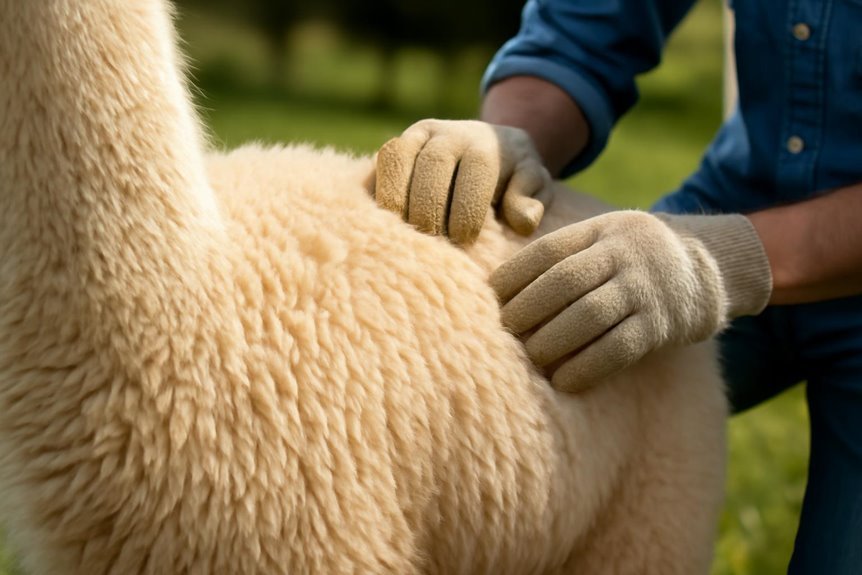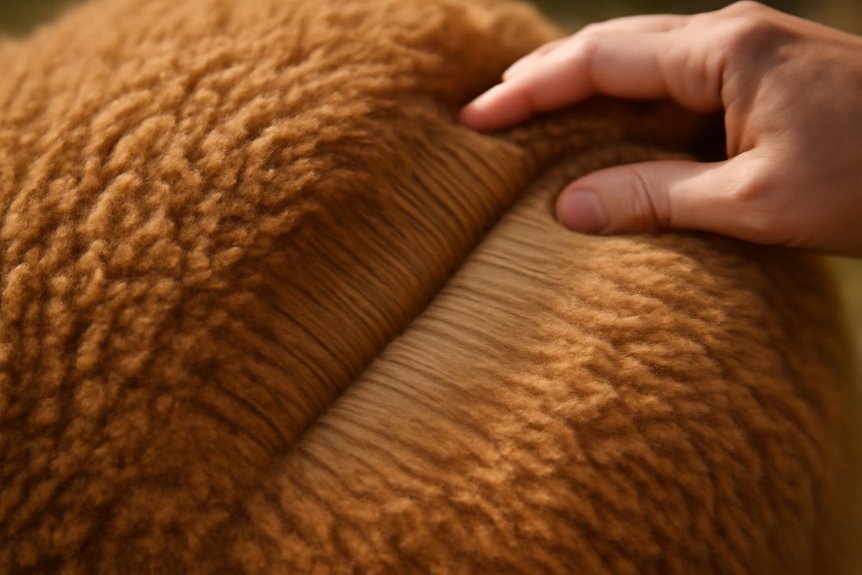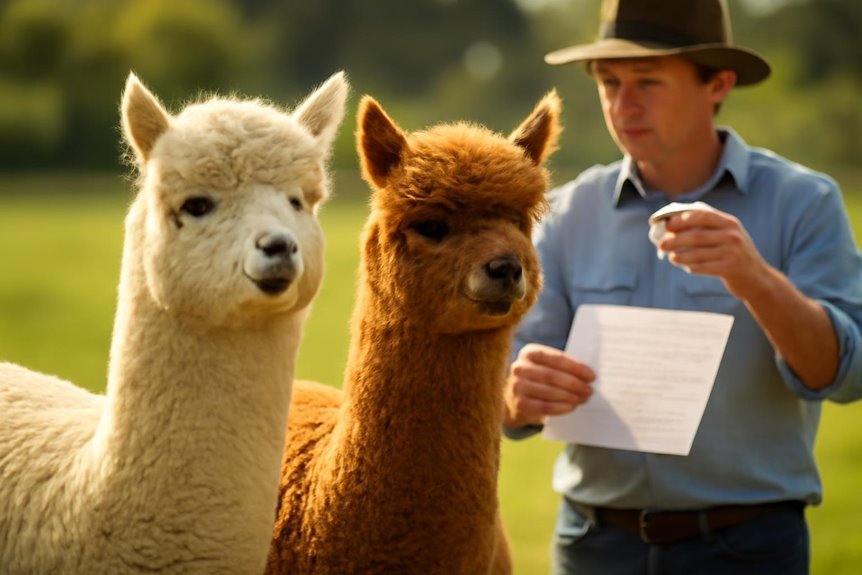10 Genetics Tips for Improving Alpaca Fleece Quality
To improve your alpaca fleece quality genetically, focus on traits with moderate to high heritability like fiber density and micron diameter. Select breeding stock exhibiting fine fibers—ideally under 25 microns—with uniformity and low variation. Match alpacas with similar superior traits to enhance genetic gain while maintaining fleece weight. Regularly test and monitor fiber traits using advanced techniques. Don’t forget to take into account nutrition and environment for best results. Keep exploring these strategies to reveal even greater fleece improvements.
Key Takeaways
- Select alpacas with high fiber density due to its strong heritability and positive impact on fiber diameter and fleece weight.
- Prioritize breeding stock with fine micron diameter under 25 microns to enhance softness and fleece quality.
- Use like-to-like genetic mating by pairing alpacas with similar superior fiber traits to maximize genetic gain.
- Monitor fiber uniformity by aiming for a coefficient of variation (CV) below 25% to ensure consistent fiber quality.
- Employ high-resolution imaging and data-driven tools to accurately measure fiber traits and track genetic progress.
Understand Heritability of Key Fiber Traits

Although genetics only partly determines alpaca fiber traits, understanding their heritability is essential if you want to improve fleece quality. Fiber diameter, for example, has moderate heritability around 30%, meaning genetics plays a significant role but isn’t the sole factor. Traits with high heritability, like fiber density—especially the number of fibers—offer effective targets for selection. By focusing on these traits, you can simultaneously enhance fiber diameter and fleece weight. Keep in mind that genetic correlations exist, so improving one trait might influence others, requiring a balanced approach. Utilizing advanced tools like image recognition and deep learning helps you accurately measure these traits, allowing informed breeding decisions. Grasping heritability empowers you to refine fleece quality while minimizing undesirable features such as medullation.
Select Breeding Stock With Superior Fiber Density
Now that you understand how heritability influences fiber traits, focusing on selecting breeding stock with superior fiber density becomes a practical next step. Fiber density, measured by hair ducts per millimeter, has high heritability and positively affects both fiber diameter and fleece weight. By choosing alpacas with elevated fiber density scores, you can improve fleece quality while maintaining adequate fleece weight. This approach also helps manage unfavorable genetic correlations between fiber diameter and fleece weight, allowing you to enhance both traits simultaneously. Use objective measurements like high-resolution imaging to assess fiber density accurately. Prioritizing animals with superior fiber density aligns with your breeding goals and guarantees you’re making informed decisions that boost overall fleece performance and production efficiency.
Prioritize Fine Micron Diameter in Selection
You’ll want to focus on selecting alpacas with a fine micron diameter, aiming for an average of 25 microns or less to guarantee soft, high-quality fleece. Consistently measuring fiber fineness helps track progress and maintain standards over time. Just remember to balance fineness with fleece weight to keep both quality and productivity in check.
Target Micron Diameter
When you focus on selecting alpacas with a micron diameter of 25 or less, you’re prioritizing fleece softness and comfort—key traits for high-quality textiles worn next to the skin. Targeting this fiber fineness guarantees your breeding program consistently pushes for genetic improvement in fleece quality. Concentrate on animals within the top 5% for fine micron diameter to maximize genetic gain, even if it means balancing with fleece weight. By setting a clear micron target, you can make informed breeding decisions that elevate the overall softness and market value of your herd’s fleece. Remember, maintaining this focus on fine micron diameter strengthens your breeding program’s ability to produce superior alpacas prized for their luxurious fiber.
Measure Consistent Fiber Fineness
Selecting alpacas with a micron diameter of 25 or less sets a strong foundation, but ensuring that fiber fineness stays consistent across your herd takes your breeding program a step further. You need to regularly measure fiber diameter using objective methods like fleece testing and histograms. This helps you track how consistently fine the fiber is within and between animals. Since fiber diameter is a moderately to highly heritable trait, focusing on animals with consistently fine fibers improves fleece quality in future generations. Prioritizing these heritable traits in your selection will reduce the prickle factor, making your alpacas’ fleece more desirable. By consistently measuring and selecting for fine fiber diameter, you can achieve a significant improvement in overall herd fleece quality over time.
Balance Fineness and Weight
Although aiming for finer fiber is key to improving alpaca fleece quality, it’s important to balance this with fleece weight to avoid reducing overall yield. Since the genetic correlation between fiber diameter and fleece weight is unfavorable, selecting solely for finer fiber diameter can lower fleece weight. You should prioritize alpacas with a micron count of 25 or less while also considering fiber density, which measures total fibers per millimeter. Increasing fiber density helps maintain or even boost fleece weight despite finer fiber diameter. Using progeny testing lets you identify males that consistently pass on both fine fiber diameter and good fleece weight. By focusing on these heritable traits together, you’ll improve fleece quality efficiently without sacrificing overall yield in your breeding program.
Evaluate Fiber Uniformity and Coefficient of Variation

You’ll want to pay close attention to fiber uniformity since consistent fiber diameter greatly improves fleece quality. Measuring the coefficient of variation (CV) helps you quantify this uniformity, with a lower CV indicating better consistency. By focusing on uniform fibers, you can produce softer, higher-value fleece that’s ideal for premium yarns.
Importance of Uniformity
When you focus on fiber uniformity, you’ll notice a significant boost in the spinability of alpaca fleece, resulting in smoother, more consistent yarn. Fiber uniformity directly impacts fleece quality and market value, so it should be a key component of your breeding goals. Uniform fibers reduce the presence of guard hairs and variability in diameter, which enhances the overall feel and performance of the fleece. By aiming for a low coefficient of variation, ideally 25% or less, you guarantee minimal diameter differences among fibers, which is essential for high-quality fleece. Regular testing and analyzing fleece histograms will help you monitor uniformity and make informed breeding decisions that continuously improve your herd’s fleece quality over time.
Measuring Coefficient Variation
Since fiber uniformity plays an essential role in fleece quality, measuring the coefficient of variation (CV) is essential for evaluating your alpacas’ fiber consistency. The CV quantifies the variation in fiber diameter by dividing the standard deviation of fiber diameter by the mean fiber diameter, then multiplying by 100 to get a percentage. A lower coefficient of variation means fibers are more uniform in diameter, which is crucial for better fleece quality. Ideally, you want a CV of 25% or less, as this indicates consistent fiber diameter throughout the fleece. Keeping track of the CV helps you select alpacas with superior fiber uniformity, enhancing fleece quality and making your breeding program more effective for producing fine fibers.
Impact on Fleece Quality
Although fiber diameter variation might seem subtle, it greatly impacts your alpacas’ fleece quality. Evaluating fleece uniformity through the coefficient of variation (CV) provides a clear picture of fiber consistency—ideally, a CV of 25% or less signals minimal diameter variation, enhancing fiber quality. Uniform fleece not only boosts market value but also supports genetic gain by allowing you to select alpacas with stable, desirable traits. Using tools like histograms to measure standard deviation and CV helps you objectively assess fiber uniformity, guiding better breeding decisions. Ultimately, prioritizing uniformity in your breeding program improves spinability and textile suitability, contributing to healthier alpacas and a more sustainable, profitable operation focused on genetic improvement and premium fleece production.
Use Genetic Correlations to Guide Trait Improvement
Understanding the genetic correlations between traits like fiber diameter and fleece weight is key if you want to improve alpaca fleece quality without unintended consequences. Since fiber diameter and fleece weight have an unfavorable relationship, focusing only on fiber diameter might reduce fleece weight. Instead, targeting fiber density traits—like total fibers per millimeter—allows you to improve both simultaneously. The heritability of individual fiber density traits is moderate to high, meaning your selective breeding efforts can effectively boost these characteristics. By considering fiber density alongside fiber diameter and medullation percentage, you tap into your alpacas’ full genetic potential. This balanced approach helps you enhance fleece quality while maintaining overall productivity, guiding smarter, more effective breeding decisions.
Incorporate Advanced Fiber Assessment Technologies
You can use high-resolution imaging to get precise, objective measurements of your alpaca’s fiber traits like diameter and density. These advanced tools help you make data-driven breeding choices instead of relying on guesswork. By adopting these technologies, you’ll be better equipped to improve fleece quality efficiently.
High-Resolution Imaging
High-resolution imaging technologies give you precise tools to measure key fiber density traits like hair ducts per millimeter and total fibers per millimeter. By using modified microscopes and advanced image recognition, you can quickly assess fiber density and related characteristics, such as fiber diameter and medullation percentage. This data helps you make informed breeding decisions that directly influence fleece quality. Research confirms that fiber density traits captured through high resolution imaging are highly heritable, making them reliable for selecting superior alpacas. Incorporating these technologies into your breeding program lets you target improvements in fiber fineness and mechanical properties simultaneously. Ultimately, high resolution imaging streamlines the evaluation process, empowering you to enhance your alpacas’ fleece quality efficiently and with greater accuracy.
Objective Fiber Metrics
Building on detailed fiber density data, objective fiber metrics bring even more precision to evaluating alpaca fleece quality. By using advanced technologies like image recognition and deep learning, you can accurately measure key traits such as fiber diameter, medullation, and micron variation. High-resolution skin imaging quantifies fiber density by counting hair ducts and total fibers per millimeter, providing essential data for your breeding systems. Since fiber traits show moderate to high heritability, you can confidently select animals that will pass on finer, denser fleece. Incorporating objective metrics like micron count and coefficient of variation helps you make informed decisions, improving both fiber fineness and mechanical properties. These tools guarantee you consistently produce high quality alpaca fleece, optimizing your breeding efforts efficiently.
Balance Fiber Fineness With Mechanical Strength
Although finer alpaca fibers under 25 microns are prized for their softness, they often come at the cost of reduced mechanical strength and fleece weight. When breeding alpacas, you need to carefully balance these traits to maintain durability in the fleece. Genetic correlations mean that increasing fineness can lower fleece weight, so focusing solely on softness might weaken your fiber. To improve both fineness and mechanical strength, pay attention to fiber density—higher total fibers per millimeter help maintain strength without sacrificing softness. Using heritability estimates around 30%, you can strategically select animals with favorable fiber characteristics. Incorporating advanced assessment tools like high-resolution imaging lets you evaluate fiber traits precisely, enabling informed decisions that optimize the balance between softness and durability in your breeding alpacas.
Implement Like-to-Like Genetic Mating Strategies

When you pair alpacas with similar desirable traits like fiber diameter and fleece weight, you increase the chances of producing offspring with consistently high-quality fleece. Like-to-like mating focuses on matching animals with complementary genetic traits to enhance fiber quality efficiently. To implement this strategy, keep these tips in mind:
- Select parents with matching low fiber diameter for finer fleece
- Analyze pedigrees carefully to avoid inbreeding
- Prioritize one key trait to maximize genetic gain
- Monitor micron count and deviation for accurate results
- Maintain genetic diversity while targeting desired traits
Monitor Genetic Gain Through Consistent Testing
To guarantee your breeding efforts are truly paying off, you should monitor genetic gain through consistent testing of fleece traits like fiber diameter, weight, and uniformity. Regularly evaluating these fleece characteristics helps you track improvements and make informed breeding decisions. Using fleece histograms to analyze micron counts and standard deviations can clearly show progress in fiber quality over generations. Incorporating a selection index that includes fiber density and medullation percentage sharpens your focus on superior traits. Testing progeny from top sires and dams also reveals the heritability of desirable fleece qualities. By consistently monitoring genetic gain, you guarantee your breeding program aligns with market demand for fine, high-quality alpaca fleece, maximizing both genetic potential and commercial value.
Integrate Environmental and Nutritional Factors in Breeding Decisions
Since environmental and nutritional factors play an essential role in alpaca fleece quality, you can’t rely solely on genetics to achieve your breeding goals. To truly enhance fleece density and fineness, integrate these elements into your breeding decisions. Focus on:
- Providing lush pastures like Cumbrian grass to maximize genetic potential
- Ensuring balanced nutrition, especially for pregnant females, to promote ideal offspring fiber
- Regularly monitoring diet quality to prevent fiber coarsening
- Adjusting feeding strategies to improve micron count and fiber softness
- Considering environmental conditions alongside genetic traits for holistic breeding success
Frequently Asked Questions
How to Grade Alpaca Fiber?
When grading alpaca fiber, you’ll assess fiber characteristics like micron diameter, consistency, and cleanliness. Using grading techniques, you’ll perform fleece evaluation focusing on uniformity, fiber length, and color to determine quality and market value effectively.
Does the Alpaca or the Llama Have Higher Quality Fleece?
When you do a fleece comparison, you’ll find alpacas have higher quality due to finer fiber characteristics and breed differences. Their softer, denser fleece outshines llamas’ coarser fibers, making alpacas preferred for luxury textiles.
How to Treat Alpaca Fleece?
You’ll want to follow proper fleece processing steps: shear carefully, use effective fleece washing techniques to remove dirt and grease, then sort fibers by quality. Finally, apply appropriate fiber storage methods in a cool, dry place to maintain quality.
What Are the Disadvantages of Alpaca Wool?
You’ll notice alpaca fiber disadvantages include low elasticity and a prickle factor above 28 microns. Alpaca wool properties like pilling and inconsistent fleece quality can cause durability and comfort concerns, affecting garment performance over time.








Our picks
Alpaca & Wool Felted Sole Inserts: Comfy Upgrade?
Best Alpaca Socks for Hiking: Ultimate Comfort and Durability on Trails
Best Alpaca Halter for Comfort and Control